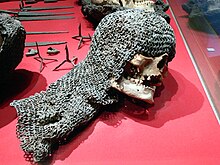Battle of Visby
| Battle of Visby | |||||||
|---|---|---|---|---|---|---|---|
 The skull of a soldier who participated in the 1361 campaign. |
|||||||
|
|||||||
| Belligerents | |||||||
|
|
|
||||||
| Commanders and leaders | |||||||
| Valdemar IV of Denmark | unknown | ||||||
| Strength | |||||||
| 2,000–2,500 men | 2,000 men | ||||||
| Casualties and losses | |||||||
| 300 | ~1,700 | ||||||
The Battle of Visby was fought in 1361 near the town of Visby on the island of Gotland, between the forces of the Danish king and the Gutnish country yeomen. The Danish force was victorious.
On 22 July 1361, King Valdemar IV of Denmark (Valdemar Atterdag) sent an army ashore on Gotland's west coast. The Gutes of Gotland paid taxes to the King of Sweden, though the population of Visby was diverse and included Russians, Danes and Germans. In 1280, the city of Visby had joined the Wendish City-alliance along with Riga, Lübeck, Tallinn and other large population centres from northern Europe, further separating Visby from the Gutnish countryside. Antagonism between the city-dwellers and the Gutnish country yeomen heightened; the latter were defeated in battle in 1288, despite the aid of knights from Estonia.
It is unknown who commanded the Gutnish army. However, he was probably a minor noble of some standing, probably with military experience. The Danish army was composed mainly of Danish and German troops, many mercenaries from the Baltic coast of Germany, with recent experience in the various feuds and wars between the German and Scandinavian states. These men would have worn what was known as Transitional armour, with iron or steel plates over vital areas and joints over a full suit of chainmail. They were led by Valdemar IV of Denmark. Against them was an army of Gutes, mainly freemen and minor nobles. The ordinary freemen appear to have worn more limited but still effective protection, with many skeletons being excavated wearing a chainmail shirt or a coat of plates to protect the torso. Some warriors may have worn a padded Gambeson or a leather jerkin or coat, though these would not have survived the decomposition in the ground after the battle. Unusually, many appear to have not had protection for their head, with many skulls wearing only a mail coif for protection, though any helmets may have been stripped from the bodies after the battle. No weapons have been discovered, but it is likely that both sides used round and heater type shields, spears, axes, billhooks, pikes and poleaxes. For close combat, both sides would have had swords, light axes, war hammers and maces.
...
Wikipedia
